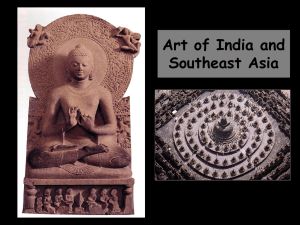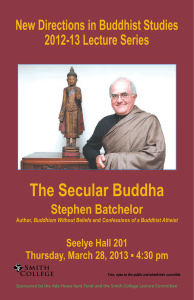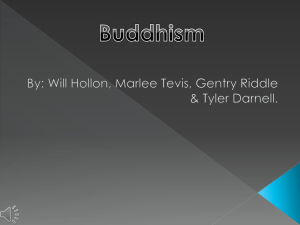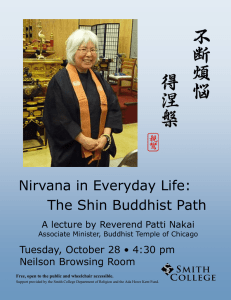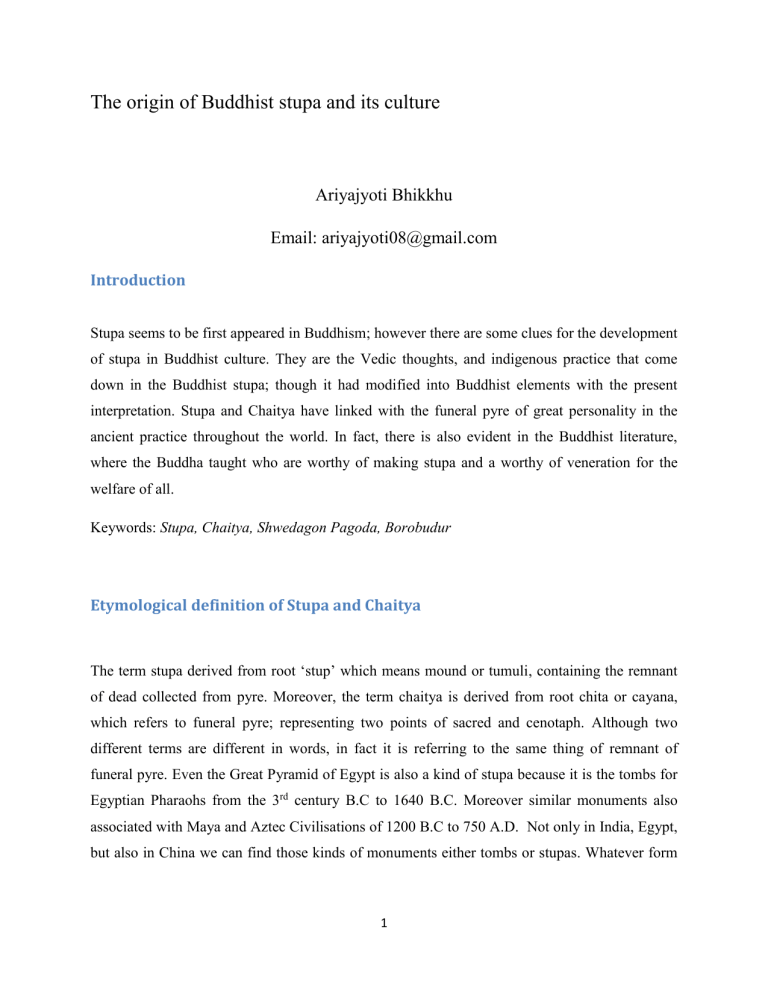
The origin of Buddhist stupa and its culture Ariyajyoti Bhikkhu Email: ariyajyoti08@gmail.com Introduction Stupa seems to be first appeared in Buddhism; however there are some clues for the development of stupa in Buddhist culture. They are the Vedic thoughts, and indigenous practice that come down in the Buddhist stupa; though it had modified into Buddhist elements with the present interpretation. Stupa and Chaitya have linked with the funeral pyre of great personality in the ancient practice throughout the world. In fact, there is also evident in the Buddhist literature, where the Buddha taught who are worthy of making stupa and a worthy of veneration for the welfare of all. Keywords: Stupa, Chaitya, Shwedagon Pagoda, Borobudur Etymological definition of Stupa and Chaitya The term stupa derived from root ‘stup’ which means mound or tumuli, containing the remnant of dead collected from pyre. Moreover, the term chaitya is derived from root chita or cayana, which refers to funeral pyre; representing two points of sacred and cenotaph. Although two different terms are different in words, in fact it is referring to the same thing of remnant of funeral pyre. Even the Great Pyramid of Egypt is also a kind of stupa because it is the tombs for Egyptian Pharaohs from the 3rd century B.C to 1640 B.C. Moreover similar monuments also associated with Maya and Aztec Civilisations of 1200 B.C to 750 A.D. Not only in India, Egypt, but also in China we can find those kinds of monuments either tombs or stupas. Whatever form 1 of structure it may be but it is built for the single purpose of mound of remnant of relics of great personality in the ancient history to till now. Earliest evident of stupa in the Pali Cannon According to scholars this kind of mound is not uncommon since prehistory period; this idea develop based on own faith and culture as in the case of Buddhist Stupa. In Mahāparinibbāna Sutta while the Buddha was giving hint to venerable Ānanda that if Tathāgata wants to extend up to aeon Tathāgata can live; Ānanda it is pleasant at Vesali, it is pleasant at Udena cetiya, Gotamaka cetiya, Sattamba cetiya, Bahuputta cetiya, Sārandada cetiya and Cāpāla cetiya. 1 According to its commentary, the Udenacetiya name coined due to building monastery for the Buddha at the place of Udenayakkha cetiya. Similarly, the rests cetiya-s also should be understood as above.2 In fact, those cetiya-s were enshrined originally dedicated to various yakṣas after whose names cetiya were called.3 Buddhist Stupa In the ancient time, the stupa or mound was crude form. But later it is developed from the simple structure of mound to highly sophisticated for particularly, we can find in the Buddhist tradition. During the lifetime of the Buddha “He directed his followers to place his cremated remains into funeral mounds (or stupas), which would serve as memorials of his life and teaching and provide focal sites for meditation and pilgrimage.4 Moreover, the practice, characteristic of early Buddhism, of enclosing a stupa in a worship or assembly (chaitya) hall in a monastery eventually burgeoned into the creation of very elaborate temples filled with numerous Buddha images.5 Dīgha Nikāya.I. 86. Dīghanikaya aṭṭhakathā.I.144. 3 Walpola Rahula, History of Buddhism in Ceylon (Colombo: The Buddhist Cultural Centre, 1993), 35. 4 Leslie Ross, Art and Architecture of the world’s Religions, (Oxford: ABC CLIO, 2009), 298. 5 Ibid., 300. 1 2 2 According to Mahāvagga the third book of vinaya text Tapussa and Bhalilikā6 who accepted the hairs relics from the Buddha enshrined in the Golden Pagoda called Shwedagon Pagoda at Yangon in Myanmar. When two merchants met the Buddha after the attainment of enlightenment, the Buddha offered them the eight strands of hairs. While they returned to Okkalapa region (present Yangon) being the native of Ramaññadesa (present Thaton), they enshrined the hair relics at the Golden Shwedagon Pagoda. The till-now-existing ancient 3rd century B.C. of Mauryan art of Sanchi Stupa archeologically is the oldest stupa in the Buddhist history. Contemporary of this stupa, the Thuparāma at the ancient city of Anuruddhapura built by king Devanam Piyatissa at 3rd century B.C. by the order of Arahant Mahinda Mahāthera. Different types of Buddhist stupa Stupa is built for paying due respect in Buddhism. Though the stupa is built for same purpose of paying respect in Buddhism, it is classified into threefold of stupa based on enshrined material. Only in the conception is different despite of similar structure of stupa. They: 1. Udissa cetiya: this kind of stupa is enshrined without relic with the sole indication of veneration for the Buddhist. 2. Dhātu cetiya: this stupa is enshrined the relics. But it may vary based on acceptance of Buddhist whether it is only Buddha’s relics is regarded as relics or even Arahant and other worthy personalities in Buddhism. 3. Paribhoga cetiya: it is stupa where it enshrines the useable things of the Buddha such as alms-bowl, stick etc. Besides this threefold of stupa, an additional type also claimed by the Buddhist i.e. Dhamma Cetiya. 6 They were from the region of Ukkalā. Further, the commentary of Mahāvagga Ukkalā refers to Ukkalājanapada. Mahavagga-aṭṭhakathā. 241. According to Burmese history one of the legendary king who built the Shwedagon pagoda was King Ukkalā(pa) during the time lifetime of the Buddha, where the seven out of eight hair relics were enshrined after the return of Tapussa and Bhalikā to their country. 3 Fundamental features of any stupa with their hidden philosophy Whatever kind of Buddhist stupa, there should have three fundamental features. They are mound, railing fence around the mound and umbrella. In addition, there are also other features; they are enclosure wall (torana-s) and circular terrace (medhi). How the Buddhist got the stupa with umbrella, four gates and circumference fence around the stupa is hushed question unless a person is familiar from the art and architectural perspective. Behind these features, scholars found, there are some hidden philosophical meanings. According to the Vāyu Puraṇa the meaning of umbrella (Chatra) represents “the worlds exist upon each upon each other like an umbrella”.7 From the Buddhist point of view scholars also opined based on the legendary Sumeru Mountain, as the centre of the universe, similarly umbrella put at the centre of the pagoda. Moreover, just as the umbrella protects the pagoda similarly, umbrella represents giving protection from all evil. Moreover, according to Hindu believes, when the universe comes into exist from nothing; it becomes egg-shape (i.e. Brahmaṇḍa). Thus, the scholars interpret, dome represent the first formation of the universe. In fact, from the Buddhist point of view, that is the place where the relics enshrined. Furthermore, railing fence around the mound is clear for the sole purpose of protection of the mound. The enclosure wall also might be based on the cardinal directions. In such case we can find The Shwedagon Pagoda the four enclosure walls with gates in the respective four directions. Moreover, the platform for the circumambulation is for showing mark of respect. Different Cults in Buddhist Countries on stupa Buddhist stupa has developed from the simple structure to complex philosophical structure. Borobudur in Indonesia is such an instance; the pagoda consists of many small surrounded stupa, Buddha statues and paintings. “The stupa symbolises the Buddhist path from ignorance and attachment to enlightenment and release via the physical ascent of pilgrims to the apex of the monument and via the subjects found in the carvings on the different levels. The base represents the sphere of earthly desire, with relief carvings of various human actions and their cause s and Uparyupari-lokānaṃ chatravat parimaṇḍalaṃ. Vāyu-Puraṇa. 50.17. ; Dr. Padma Sudhi, Symbols of Art, Religion and Philosophy (New Delhi: Intellectual Publishing House, 1998), 111. 7 4 consequences.”8 Moreover, the present Shwedagon Pagoda of Burmese stupa Architecture reaches its apex. They developed the stupa into astrologically unlike other stupas in Buddhist countries based on Hindu astrology. The planetary structure of Shwedagon Pagoda are Sun, Moon, Mercury, Venus, March, Jupiter, Saturn, Rahu and Ketu. Indeed, the stupa is octagonal. To be one success, healthy and wealthy the person will pay homage from Monday Corner when he was born on Monday. On the other days also similarly should be understood. It is said that the Burmese adopted from Hindu astrology the Rahu and Ketu terms though they interpret differently. According to Hindu astrology Rahu and Ketu is the dragon head and tail whereas in Burmese it is a separate planet. Moreover, Ketu is believed the king of all planets. As in many other languages, the Burmese name the seven days of their week after the seven planets, but Burmese astrology recognizes an eight day week, with Wednesday being divided into two days; until 6 p.m. it is Wednesday, but after 6.pm. until midnight it is Rahu's day.9 Cults on stupa constituent and worshiping In Buddhism still many things which are not clear even the Buddhist how their practices come about, though they know what they are doing is simply for acquiring merit; particularly the practice related to Buddhist stupa. Circumambulation In Pāḷi it is called padakkhiṇa. There are sufficient references in Tipiṭaka, when Brahma, monk, deva, king, visited to the Buddha, they made circumambulation and they left the Buddha. 10 According to Dr. Sudhi, “walking round of an object, person or sacrifice to influence, to honour or to purify is ethnic in nature”.11 According to Chinese version of Tripiṭaka the people of Ceylon (Sri Lanka) mark their time by the sun’s shadow. Thus, the writer of the Tripiṭaka (belonging to the 7th century A.D.) says that from this custom is derived the religious ceremony pradakṣinā..that is turning to the right in conformity of the Sun’s shadow in other words, turning sun way. The Brahmanic literature of India explained the Pradakṣinā culture in India represents Leslie Ross, Art and Architecture of the world’s Religions, (Oxford: ABC CLIO, 2009), 305. Skidmore, Monique. Burma At The Turn Of The Twenty-first Century. University of Hawaii Press, 2005, p. 162. 10 Idamavoca, bhikkhave, so mahābrahmā, idaṃ vatvā vipassiṃ bhagavantaṃ arahantaṃ sammāsambuddhaṃ abhivādetvā padakkhiṇaṃ katvā tattheva antaradhāyi. Dīghanikāya.II. 40; Cūlavagga. 291; Dīghanikāya. III.175; Majjhimanikāya. I. 200. And many more places throughout Tipiṭaka, Commentaries and Sub-commentaries. 11 Dr.Padma Sudhi, Symbols of Art, Religion and Philosophy (New Delhi: Intellectual Publishing House, 1998),233 . 8 9 5 daily march of the Sun, which is our hemisphere rises in the East, passes then to the South and sets in the West. Moreover, the Satapatha Brahmaṇa says, while performing Pradakṣinā-they think Sunwise this sacred work of ours shall be accomplished; and therefore they again walk thrice round sunwise.12 Offering While the devotees visit to the pagoda, they offer flower, incense stick and other offering also. In fact, this offering practice among the Buddhist is nothing to comment since it is obvious for every Buddhist for the aim of gaining merit due to honour of the triple gem. Pouring water This practice is commonly seen among Buddhist stupa in Burma, where in each corner based on birthday the devotee pours water to the Buddha statue. In the common sense, water washes away all the dirty things. Similarly, the Buddhist has the concept of washing the Buddha statue means washing away owns misfortune. Therefore, they pour water to the Buddha statue. From the Buddhist theory of acquiring merit can relate this pouring water with the keeping away of misfortune. Whenever a person mind is endowed with confidence (saddhā), effort (vīriya), concentration (samādhi), mindfulness (sati) and wisdom (paññā), unwholesome mental factors do not have chance to arise in one’s own mind. Hence, by acquiring merit all the time, the other unwholesome resultant (vipāka) also will not have to give result. Conclusion Though making stupa is an ancient practice blended in Buddhism, it is never opposed with the teaching of the Buddha. Due to it beneficial deed, it is worthy to make for acquiring the merit. Moreover, it cults practices in respective countries is also good to continue, because it lead towards the spiritual development. As a worthy of veneration, everybody has chance to earn merit by paying due respect to the stupa. 12 Ibid.,235. 6
